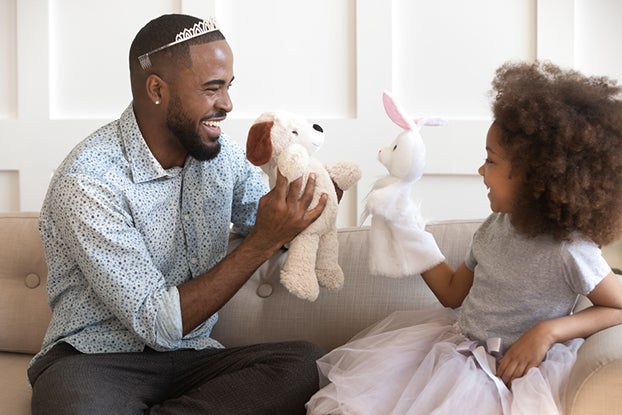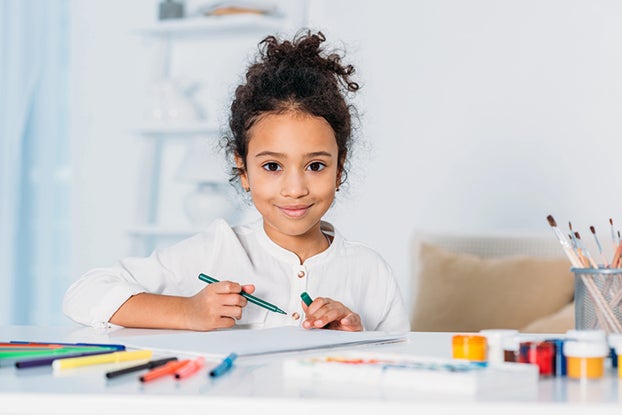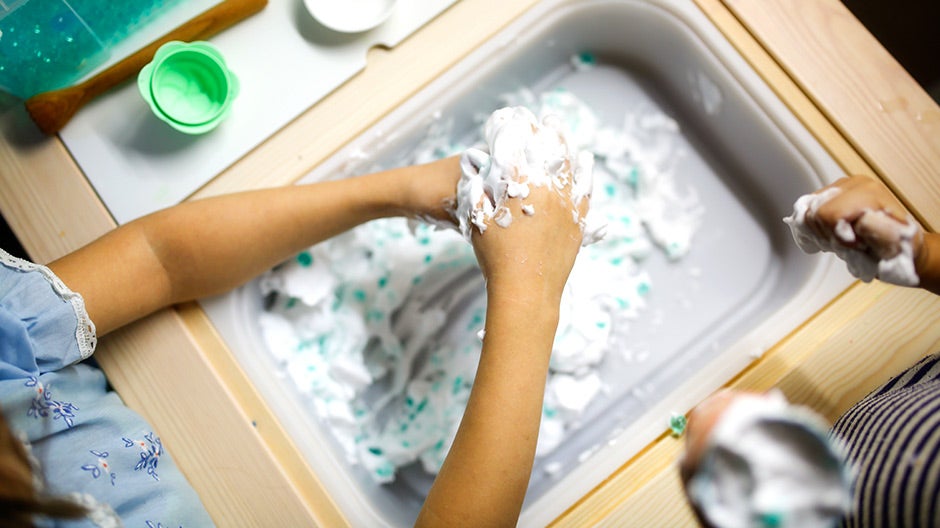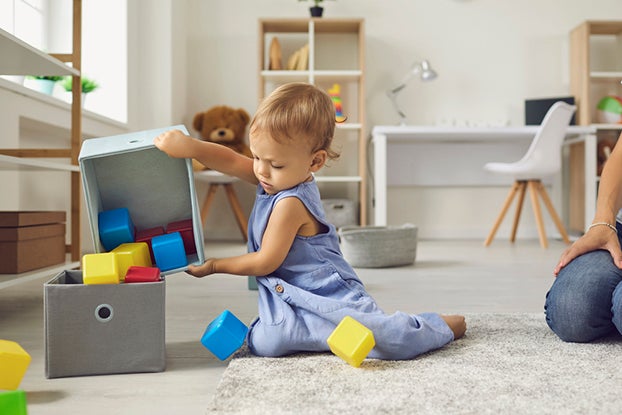It’s a bird; it’s a plane; it’s your toddler running around holding a toy broom, pretending to be a superhero! Pretend play, also known as creative or make-believe play, allows children to use their imagination to act out different roles and scenarios.
This type of play is not only fun for children, but it also serves an important role in their development. Let’s explore pretend play in more detail and discover why it benefits kids. We’ll also share several ideas for fostering creative play in your child.
Table Of Contents
- What Is Pretend Play?
- Importance Of Pretend Play
- Tips To Encourage Pretend Play
- Ideas For Pretend Play
What Is Pretend Play?

Pretend play is when children engage in imaginative and creative activities. This can include:
- Using dolls, stuffed animals, or action figures as characters
- Creating imaginary scenarios
- Dressing up in costumes
- World building
- Using props and toys to act out events
This type of play is often inspired by real-life events or by your child’s favorite books, movies, or TV shows. It can range from playing house to pretending to be a doctor or firefighter. There’s no “right” way to pretend.
When Does Pretend Play Start?
While simple pretend play begins as early as 18 months, it becomes more complex and sophisticated as children grow. At first, your child may imitate your actions or use objects as intended. For example, they may pretend to drink from a toy cup or talk on a play phone.
As they develop and learn more about the world around them, their pretend play becomes more advanced. They may start to incorporate different roles, use props creatively, and create elaborate scenarios with longer storylines.
Pretend play is a staple throughout childhood, so you’ll likely continue seeing your kids engage in it as they enter elementary school and beyond.
Importance Of Pretend Play

Pretend play is more than just fun and games. It has a significant impact on your child’s overall development.
It helps kids:
Learn More About The World
Through pretend play, children can explore and learn about the world around them in a safe and controlled environment. They can mimic real-life experiences and gain a better understanding of different roles, occupations, and relationships.
Boost Imagination And Creativity
Pretend play encourages children to think outside the box. They can create their own stories, characters, and scenarios without limitations. They are the author, director, and actor in their own play.
Develop Critical Thinking Skills
When children engage in make-believe play, they can unlock higher-level thinking skills such as:
- Problem-solving
- Decision making
- Critical thinking
- Planning
- Impulse control
This helps them develop important cognitive skills that will benefit them in all aspects of their lives, from academic success to personal relationships.
Build Emotional And Social Skills
Pretend play allows children to experiment with different emotions and social scenarios, helping them learn how to regulate their own feelings and interact with others.
It also gives them the opportunity to practice social skills such as taking turns, sharing, and making compromises.
Improve Communication Skills
This type of play often involves storytelling and using language in various contexts, making it an excellent opportunity for your child to enhance their communication skills.
By engaging in dialogue and role-playing, they learn new words, sentence structures, and how to express themselves effectively. This is particularly beneficial for children struggling with speech or language delays.
Practice Cooperation And Teamwork
When children engage in imaginative play with their peers, they learn the importance of cooperation and teamwork. As they plan and play together, they develop compromise, negotiation, and conflict-resolution skills.
These are all crucial for building positive relationships and functioning in group settings.
Work Through Real-Life Challenges
Life isn’t always easy. Big feelings and difficult situations can be hard for children to process. Pretend play provides an outlet for them to work through these challenges.
By pretending to be characters facing similar struggles, your child can explore different solutions and better understand how to handle real-life situations.
Since play often mimics real life, don’t be surprised if your child incorporates death, illness, or other sensitive topics into pretend play. This is a normal part of processing and understanding difficult concepts.
Encourage open communication and provide reassurance when needed.
Tips To Encourage Pretend Play
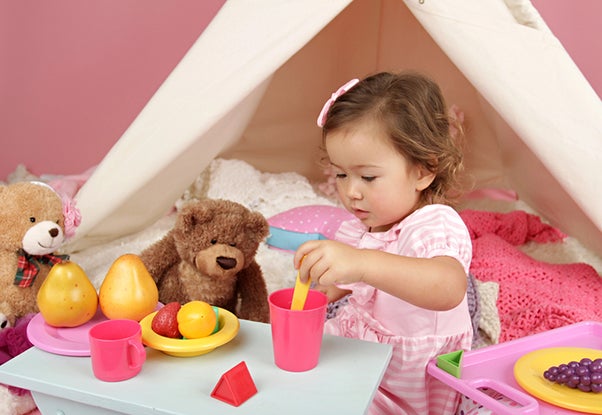
Some kids are natural-born storytellers and thrive in imaginative play, while others need a little guidance and encouragement.
Here are some tips to help you foster pretend play in your home.
Supply Open-Ended Toys
Open-ended toys don’t have a “right” way to play. Instead, your child can use them in a variety of scenarios.
Here are a few to consider:
- Building blocks
- Dolls and action figures
- Craft Discovery Kits from Little Passports
- Play food and kitchen sets
- Art supplies like markers, paper, paint, and stickers
Create A Stash Of Dress-Up Clothes
Dress-up clothes are a great way to inspire imaginative play. Collect old costumes, hats, scarves, and other items from around the house, or visit a thrift store and select some inexpensive pieces of clothing.
Don’t feel limited to actual costume pieces. You and your child can transform everyday items into exciting new looks with a bit of imagination!
For example, a towel can become a superhero cape, or a button-up shirt can instantly become a doctor’s coat.
Join In On The Fun
Your kid loves it when you play with them! It strengthens your bond and shows them that it’s OK to let their imagination run wild.
Put on a silly hat, grab a toy instrument, or use your best dragon voice to join in on their pretend adventures.
At first, you may need to take the lead. But soon enough, your child will come up with their own imaginative scenarios and want you to join in.
So get ready to play hide-and-seek in a magical castle or be served tea at a pretend party.
Use Stories As A Launching Pad
Reading books or telling stories together can inspire pretend play.
For example, after reading a book about:
- Pirates, your child may want to dress up as one and go on a treasure hunt.
- A princess, you may see your child wearing a sparkly crown and trying to rule over their stuffed animal subjects.
- Firefighters, they may put on a red hat and save their toys from a burning building.
- Dinosaurs, there might be a silly T-rex stomping around your living room.
You can also encourage them to tell their own stories to get their play started. The Magnetic Story Box in the Explore Letters Kit from HOMER makes storytelling fun.
Ideas For Pretend Play
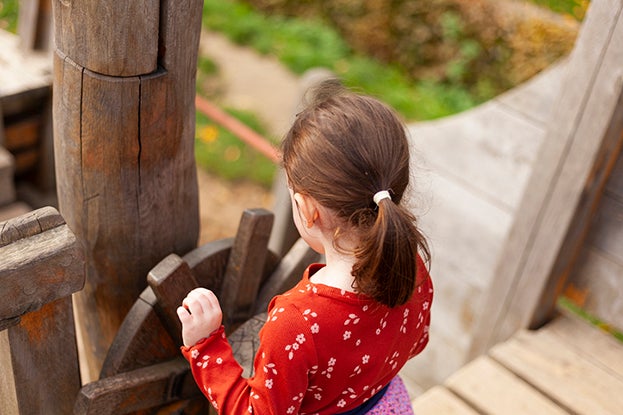
Now that you know more about pretend play, let’s look at specific ideas for different age groups.
Toddlers
While most toddlers aren’t ready for elaborate creative play, they love to imitate everyday activities. You may even notice them engaging in object substitution, which is when they use one object like another.
To help your toddler engage in pretend play, try:
- Setting up a toy kitchen with plenty of different toy food options
- Giving them a toy phone to make “calls”
- Leaving an empty cardboard box for them to crawl in and out of
- Building barns out of blocks for their toy animals
- Setting up simple sensory activities, like a bowl of soapy water so they can wash their toy cars
Preschoolers
Preschoolers are masters of imagination and often spend much time in the worlds they’ve created. They may even have an imaginary friend or two.
This is the perfect time to introduce simple props like costumes, masks, and playsets. You can also:
- Create a pretend store with a toy cash register and fake money
- Build forts with blankets, chairs, and pillows
- Put on a puppet show using homemade puppets
- Invite a friend over so they can practice social skills as they pretend together
School-Age Children
As your child enters school, their imagination and creativity continue to grow. They may enjoy more complex pretend play activities such as:
- Creating a whole town or city with blocks, LEGO bricks, or other building materials
- Making elaborate costumes or trying their hand at face painting
- Using props like toy phones, laptops, and briefcases to act out scenarios as adults
- Acting out how they’d survive if they were an orphan in the Wild West
- Making up their own game for themselves or others
Loads Of Fun With Pretend Play!

Pretend play provides an invaluable opportunity for kids to practice their creativity, problem-solving, and social skills in a fun way. So, gather some simple props, encourage their imaginative journeys, and enjoy watching your child’s talents and abilities blossom.
And remember that you don’t have to do it alone. At Begin, we’re your learning partner. Our membership is the perfect combination of hands-on and digital play personalized to your child’s age and learning needs.
With the Begin Approach, you can focus on the milestones that actually matter for kids to grow up capable and confident!
Get started today by taking this short quiz.
